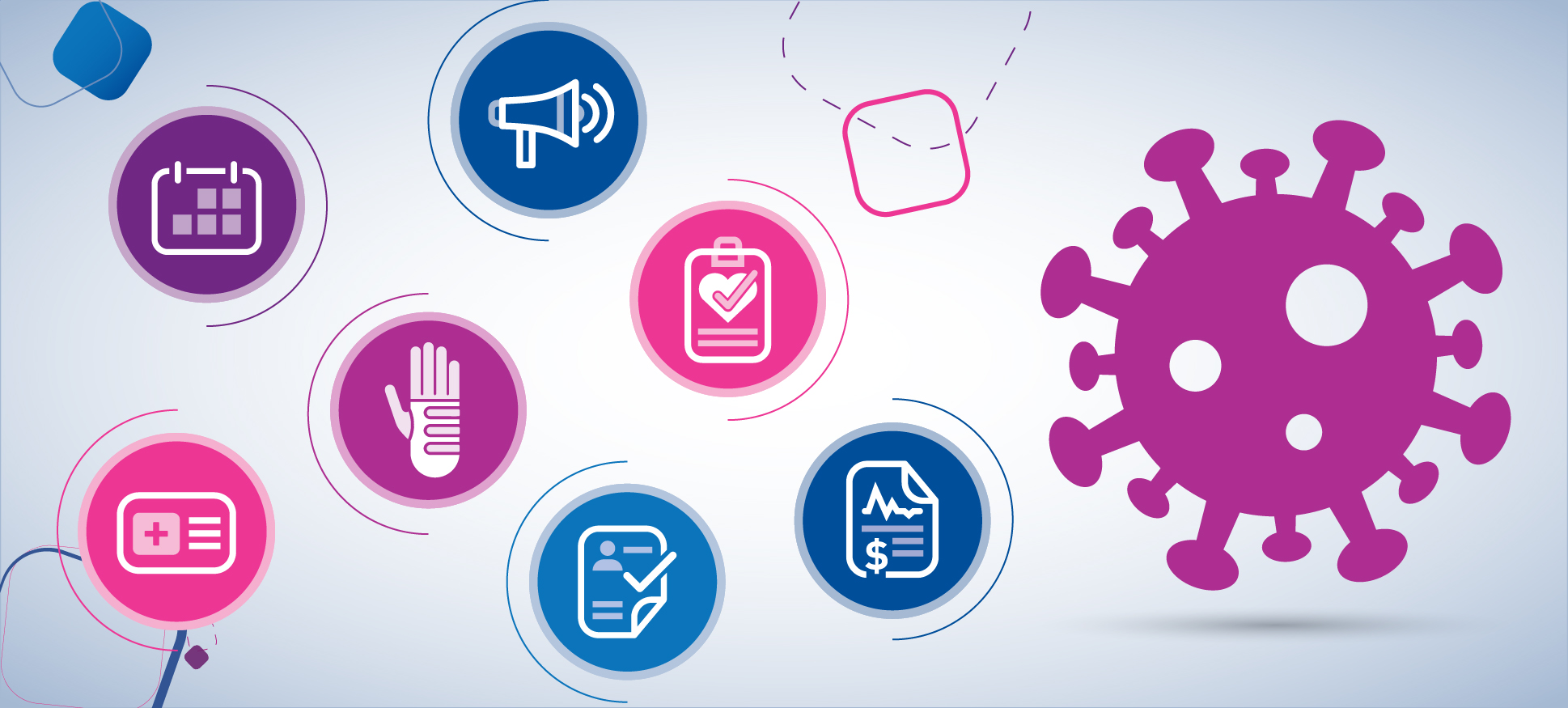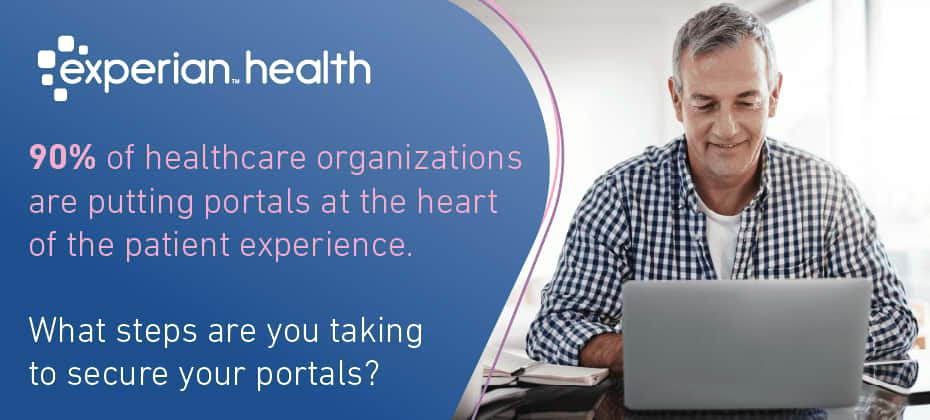Tag: patient portals

COVID-19 transformed the patient journey, and it's clear when we evaluate every step. Data and technology gave patients the convenience, flexibility, and control to get care on their terms, and these changes will be here to stay. From marketing to scheduling to payments and more - providers and payers have ample opportunities to respond to these changes and will need to adapt their future strategies accordingly. Self-scheduling, mobile registrations, and automated authorizations are a few examples of tools and technologies that are more than likely to remain prominent in healthcare. What other changes are here to stay? In this new infographic, we take a dive into each of the 7 steps to see how data and technology has impacted the patient journey, and provide strategic recommendations on how providers and payers can adjust post-pandemic: The use of data and digital tools opened up new doors for greater patient access, engagement, transparency, and control. The post-COVID-19 patient journey is going to continue to evolve - payers and providers will need to adapt to keep up with the changes, to ensure that patients experience the best outcomes. To get a deep dive into all of the changes to the patient journey, download our white paper.

This is the third in a series of blog posts highlighting how the patient journey has evolved since the onset of COVID-19. Explore how digital patient intake solutions are transforming the registration process - presenting patients with self-service options and providers with an automated and more efficient process. To read the full white paper, download it here. Registration is a familiar pain point in the patient journey, but COVID-19 has pushed both patients and providers to embrace digital patient intake processes and solutions. These new solutions move registration out of the waiting room, reduce errors and inefficiencies, automate billing, payments and create an enterprise-wide approach to data. Digital patient registration, once considered a “nice to have,” is now a widespread priority. A reveals that 88% of providers plan to invest in patient intake capabilities as a result of the pandemic, up 15% over a year ago. Patients lead the way on post-pandemic digital experiences COVID-19 marked a tipping point in the digital patient experience. Contactless care in the form of telehealth, along with increased use of patient portals and self-service scheduling tools, helped patients access care from a distance. Now, even though 81% of patients say they believe their provider has made on-site facilities safe, many still prefer online and mobile registration options. The study also revealed that 64% of patients prefer an online or mobile-enabled registration experience. “There’s an ‘ick’ factor,” explains Spiro Kalapodis, Director of Product Management for Registration Accelerator and Patient Financial Advisor at Experian Health. Patients actively dislike filling out paper forms, using registration kiosks and handling iPads set out for public use. “I don’t blame them,” says Kalapodis. “Even though the initial wave of COVID-19 restrictions has passed, I would prefer completing the registration process from the comfort of my car, rather than fill out forms in a crowded waiting room.” Simplifying a difficult process with digital registration and digital patient intake solutions One reason automated registration can be such a relief is that manual processes are notoriously difficult for providers to manage. Manual patient registration has always been labor-intensive and subject to human error; COVID-19 magnified these limitations. Paper forms are inefficient – they require design, printing, paper, clipboards, pens, secure storage and disposal. So many things can go wrong: receiving illegible responses, inputting data incorrectly, misplacing forms, the list goes on—and each step consumes valuable staff hours, with questionable results. Meanwhile, patients moved, visited new providers, changed jobs and switched insurance companies which meant there was more information needing capture. At the same time, providers are struggling to recoup revenue that was lost when patients deferred care during the pandemic. Optimizing both human and digital resources is key to delivering on an improved patient experience and regaining consistent profitability. “Patient intake solutions automate everything so data can be used consistently across the patient journey,” says Kalapodis. “For example, when a patient scans their insurance card and submits it through Experian Health’s Registration Accelerator, we leverage technology behind the scenes that can automatically indicate the patient’s insurance provider, policy details, and correctly return the patient’s subscriber details —information that staff members otherwise have to figure out for themselves. By automating this process, we’re saving time and resources, reducing misunderstandings and preventing data entry errors, which can be costly for providers and confusing for patients.” With the right data, providers can also create accurate estimates and even invite patients to pay their bills as part of the registration process. The patient receives a text message with a link to their estimate, along with the opportunity to pay online or on their mobile device. “Not only does this streamline the billing and collection process for providers, it creates a frictionless experience and increases greater transparency for the patient,” says Kalapodis. Getting to a single view of the patient Maintaining accurate data records can help providers deliver smooth patient experiences, better care, simpler payment processes and allows for better communication. Unfortunately, COVID-19 created another challenge on this front. During the pandemic, many patients signed into patient portals to schedule vaccine appointments. In their hurry to secure a shot, many inadvertently created duplicate accounts—and now have duplicate records. Obviously, multiple vaccine logins are not the only source of duplicate, inaccurate and incomplete patient data. But thanks to COVID-19, providers have this additional problem to contend with. Automation can make fast work of data issues. A universal identity manager creates a single view of the patient using unique patient identifiers, which prevent duplicate data records. The result: fewer billing errors and reduced associated costs, better care and a more frictionless patient experience. Patient intake can be painless Digital patient registration was a good idea even before COVID-19. Paper forms, entry errors, fragmented data, duplicate records, slow billing, and a lack of transparency made the registration process costly and inefficient. But COVID-19 made the need for digital more acute. Providers that hope to re-engage patients and recover profitability in the post-COVID-19 era need the power of data and automation. Learn more about how Experian Health can help you deliver a patient registration experience that fits post-pandemic expectations while improving efficiency, reducing errors and leveraging patient data. Download the white paper to learn how digital patient intake solutions are revolutionizing healthcare. Missed the other blogs in the series? Check them out: 4 data driven healthcare marketing strategies to re-engage patients after COVID-19 How 24/7 self-scheduling can improve the post-pandemic patient experience

The delta variant is still surging – and flu season is about to begin. How can healthcare providers leverage innovative technologies to streamline care and prepare for a potential “twindemic?” The summer of 2021 has not been kind to healthcare professionals. After a brief period of hope that the worst of the COVID-19 epidemic was over, the delta variant started its march across America, flooding hospitals and physician practices with a new wave of seriously ill patients. Autumn and winter look like they might be trouble, too, as delta joins forces with the seasonal flu to form a potential “twindemic.” After a mild season in 2020, many experts are predicting that the flu will reemerge with a vengeance this year as people return to in-person work and school. The combination of the two illnesses could easily overwhelm providers who aren’t prepared with technologies and workflows that allow them to serve patients efficiently and remain responsive to fluctuating demands. As providers look to navigate the coming months, they will need to make sure that they have self-service tools in place to keep patients safe and relieve strain on staff. With a few key digital solutions, resources can be maximized, unpredictable patient volume can be managed effectively, and difficult circumstances won’t slow down operations. Online self-scheduling can improve experiences for patients and staff Online self-scheduling is in high demand because it provides flexibility. patients want to move on with their busy lives without having to sit on hold with a representative. In Experian Health’s recent survey, the State of Patient Access 2.0, more than seven out of ten patients wanted to take the appointment-making process into their own hands, citing the speed and convenience of choosing their own appointments. Providers and physician groups appear eager to oblige. More than 70 percent of providers responding to the survey stated they are planning to offer online appointment tools to improve experiences and manage complex operations as the pandemic continues. The benefits for providers are significant. Online self-scheduling can measurably reduce administrative burdens on staff, allowing practices to reallocate their people power to other high-priority tasks. Giving patients the tools to make appointments may also help to reduce patient no-show rates, which can drain billions of dollars each year from provider organizations. Using self-scheduling tools, patients with transportation issues or concerns about exposure risks may be able to opt for telehealth visits, as opposed to unplanned visits to urgent care centers or the emergency department. This can help protect other consumers and staff from illness while allowing them to manage their own calendars. Mobile patient registration keeps patients safe from exposure during a "twindemic" Shifting patient registration from the clinic to the home can also be beneficial for patients and providers. When patients fill out new forms or update existing information in person, they increase their exposure risk by staying in the waiting room longer than necessary. In contrast, a digital registration accelerator solution offers a quick, touchless, and convenient intake experience on the patient’s own mobile phone. Patients can complete the process in their homes (where they are more likely to have all their personal information at hand), or in the parking lot while waiting for clearance to enter the building. On the provider’s side, automating patient intake improves operational efficiency and avoids errors that come from illegible handwriting and verbal information communicated through masks and plexiglass. Data integrity algorithms and real-time feedback for patients can correct mistakes quickly to ensure high accuracy of patient data – a crucial competency for treatment and reimbursement. Patient portals boost convenience, communication, and security As providers prepare to battle two illnesses instead of just one, practices shouldn’t forget to leverage one of the most important parts of the digital arsenal: the patient portal. Portals are instrumental for staying connected with patients, particularly with the 40% of patients who skipped medical care in the early months of the pandemic. As a complement to necessary in-person care, patient portals offer a convenient way to communicate with providers, complete administrative tasks, and access personal health information at their leisure. Providers must be certain, however, that their portals don’t become avenues for medical identity theft. Healthcare organizations must maintain tight security policies that simultaneously deliver an optimized patient experience. A patient identify-proofing and authentication solution that automates patient portal enrollment while adhering to the high standards of HIPAA and other industry requirements is key. Solid security can reassure patients that sharing digital health information with their trusted providers is safe - fostering more open relationships and leading to better care. Hopefully, fears of a “twindemic” will fizzle as communities continue to take sensible precautions against the spread of COVID-19. However, if the flu does roar back into life, providers must be prepared. Self-service technologies and robust security measures can safeguard practices against the strain of higher-than-expected patient volumes and supporting the continued delivery of high-quality patient care. Learn more about how Experian can help your organization incorporate these new technologies and prepare for a potential "twindemic."

COVID-19 changed every aspect of the patient journey – placing unprecedented demands on the healthcare system and accelerating the need for digital transformation industry-wide. Telehealth, touchless engagement, and self-service scheduling became the new normal; however, this created new stress on operations, administration, and finance. While this new normal comes with many challenges, data and digital tools have created greater accessibility, engagement, transparency, and control for patients and providers. In this blog, we examine COVID-19’s impact on the patient journey and explore the digital tools and data that are helping the healthcare industry recover and thrive. To get more insights, read the full whitepaper here. COVID-19 strained the healthcare system more than ever before. To say that COVID-19 challenged the healthcare system is a massive understatement. Seven in 10 patients deferred or canceled treatments during the pandemic, causing disruptions to both revenue and patient engagement. Even behind the scenes, novel diagnostic codes and new sources of information—together with rising inpatient volume and government intervention—affected costs, billing and reimbursements at scale. Patient-provider relationships became much more complex. Many people moved, changed jobs and changed insurance during the pandemic. In fact, an estimated 40 million Americans lost work during the pandemic and just over half of all workers in North America plan to look for new work in 2021. As a result, relationships between physicians and patients became disrupted. While re-engagement is critical for providing care, simply finding patients remains a challenge. The digital experience raised patient expectations. As consumers turned to technology to cope with changes, digital engagement increased in healthcare services and elevated consumer expectations. This trend began before the pandemic: A pre-COVID-19 AARP survey of older adults (50+) found that a majority would prefer to have their healthcare needs managed by a mix of medical professionals and technology. During the pandemic, patients used telehealth to access care from home, mobile registrations to avoid filling out paperwork in the waiting room and digital payment options that made paying bills simple and seamless. Now that patients have experienced telemedicine, self-service scheduling and easy digital payments, there is no going back. Expectations have changed permanently, and providers that don’t offer an updated patient experience may suffer by comparison. Opportunities for better outcomes: transforming the patient journey with digital transformation We looked at key parts of the patient journey where technology is helping healthcare providers engage and care for their patients successfully across the marketing, scheduling, registration, authorization, treatment, claims and payment. Here are a few strategic opportunities for providers to consider post-COVID: 1. Use smart data for better outcomes Third-party data is helping providers find and re-engage patients, deliver more holistic care and facilitate better financial outcomes. For example, integrating data on social determinants of health (SDOH), can provide physicians with a more holistic picture of non-medical factors that may influence medical outcomes, such as a patient’s socioeconomic status. SDOH data can also shine a light on a patient’s ability to pay, which in turn may inspire a wider range of payment options so that more patients can afford care, and more providers can avoid write-offs. 2. Continue using technology and automation for the recovery to come Using digital self-service applications for registration does more than just provide the patient-friendly option of completing paperwork at home (instead of the waiting room). It also eliminates the need for staff hours spent inputting information, reduces the potential for error, and improves efficiency. Advances in automation make it possible for providers to reduce the effort of manual tasks - like sorting through patient records from disparate sources to create a single, comprehensive patient file, or gathering the information necessary to revisit claims authorization for deferred care. Across the board, digitalization provides greater transparency, flexibility, and seamless experiences for patients and providers alike. 3. Clear the path for payments Going digital can help patients and providers better navigate the patient journey, especially when it comes to payments. As many as half of nonretired adults expect long-term financial effects as a result of the pandemic. This makes it more imperative than ever to improve and accelerate authorization, claims, and payment processes so that both patients and providers have a clearer understanding of how care will be paid for. Accurate patient estimates, coverage discovery, automated authorizations, and payments all play a role in creating a better financial experience going forward. Digital transformation gains traction as we look to the future Although the digital transformation was already underway before COVID-19, the pandemic has accelerated the need for data, automation, and self-service tools. Find out how Experian Health can help your organization meet the data challenges of the post-COVID-19 patient journey by downloading our white paper.

"93% of providers say creating a better patient experience remains a top priority, up 3% from last year." - Experian Health's State of Patient Access, June 2021 In November 2020, we surveyed patients and providers for their sentiments on how patient access changed because of the pandemic. During this time, patients welcomed the convenience and control that came with digital, contactless care. Providers knew they needed to improve their digital front door to withstand the financial impact of COVID-19, but implementation was difficult for many organizations. Six months on, and millions of immunized Americans later, the pandemic landscape shifted again. In June 2021, we revisited these questions to find out if patient and provider views have changed - in our State of Patient Access 2.0. Now, patients tell us they feel more confident about returning to facilities, though they still want the flexibility and convenience of digital scheduling, registration, and payment options. Providers feel a growing urgency to make sure online services are sufficiently agile enough to withstand any future surges in COVID-19 case numbers. The findings of the survey reveal four major opportunities to rethink how we “do” healthcare. By innovating and building on the digital advances made possible during the pandemic, providers can create better patient access experiences for the future. To start, providers should: 1. Match consumer expectations for convenient and flexible patient access Our recent survey shows that the pandemic has cemented consumer expectations around convenient access to care. Digital and remote channels for scheduling appointments, completing pre-registration, and making payments have become the new baseline in patient access. Nearly three quarters of patients told us they want to schedule their own appointments online. Providers know this: 93% say creating a better patient experience remains a top priority, up 3% from last year. Online self-scheduling can help providers continue to meet their patients’ demands for flexibility and convenient access to care. Patients can find, book and cancel appointments whenever and wherever they prefer. It’s also a win for providers, who can expect to see a drop in administration errors, no-shows, and denied claims. 2. Streamline prior authorizations as more patients return to care Interestingly, new data reveals that patients are less anxious about in-person care. In 2020, 40% of patients were uncomfortable coming into waiting rooms and seeing their doctor in person. Now, only 16% say they wouldn’t be comfortable in a waiting room. As more patients rush to reschedule deferred care, providers are faced with the challenging combination of higher patient volumes, patients jumping health plans as a result of job losses, and changing payer rules around prior authorizations and coverage checks. Automated pre-authorization and automated coverage checks can relieve the pressure, and help providers save time and resources. 3. Promote price transparency for fewer missed payments An encouraging piece of insight from our latest survey reveals that far fewer patients say they’ve been surprised by their final medical bill. In 2020, more than 50% received a final figure that differed significantly from estimates. Six months later, that figure has dropped to just 14%. Price transparency remains important, and the gap between estimated and final costs seems to be closing. More providers are offering patient billing estimates, with 9 in 10 agreeing that accurate estimates increase the chance of bills being paid on time. Many are also giving patients more options to pay bills earlier in the journey, which has helped to minimize the risk of late and missed payments. Easy and accessible digital options are featured heavily in acquisition and retention plans, and can help drive financial recovery. 4. Tighten up data strategies with better security, quality and insights While our first survey revealed that the sudden shift to digital-first patient access was a shock to the system for many providers, the second study shows that both patients and providers are settling into digital ways of working. But as these digital services become the new baseline, providers must make sure their data strategies are fit for purpose, and prioritize data security, quality and insights. Moving forward, a multi-layered approach will help providers authenticate and secure patient identities. When these identities are enriched with information about how patients are affected by the social determinants of health, providers will be better positioned to offer personalized patient access experiences and support marginalized groups. The future of healthcare is digital. Is your organization prepared? It’s clear from our recent survey that the digital trends that emerged in 2020 are set to continue throughout 2021 and beyond. Download the State of Patient Access 2.0 white paper to get the full survey results and explore how data and digitalization can power a 24/7 patient access experience in your healthcare organization.

Consumer-led care hit its stride during the pandemic. COVID-19 unlocked healthcare’s digital front door, giving patients more control over how and when they schedule and manage appointments. Unfortunately, while digital patient access has made navigating the healthcare system more convenient and flexible in many ways, consumers are discovering that one of the more frustrating aspects of the healthcare experience has failed to keep pace with scheduling, payments and other digital advances: registration. Waiting rooms. Paperwork. Misplaced insurance cards. Confusing copays. More paperwork! A hassle before the pandemic, registration has become even more challenging for staff and patients in the context of “contactless care.” With more patients starting to come back through the door as a result of vaccination programs and rescheduled elective procedures, there’s an opportunity for providers to smooth out the kinks in the registration experience. Vaccine “hesitancy” has exposed wider issues in patient registration Headlines suggest that large numbers of patients are fearful of being vaccinated against COVID-19. But dig a little deeper, and the issue is more complex. Many patients do want to be vaccinated, but struggle to navigate complicated registration websites, and therefore aren’t showing up for their shot. The Kaiser Family Foundation reported in January that two thirds of patients were unsure of how to access the vaccine. The high volume of patients having trouble getting the information they need is shining a light into the dark corners of the registration process, where improvements have long been needed. Improving the patient registration process isn’t just a pandemic problem While it’s true that COVID-19 is driving the push for online patient registration, improving the overall experience offers wider, longer-term benefits to patients and providers: A convenient and consumer-friendly registration experience Online registration is easier, faster and simpler for patients. With 73% of consumers saying they want to manage their healthcare admin through patient portals, convenient self-service solutions are a trend that’s here to stay. (Find out more about consumer attitudes to patient access in Experian Health’s Patient Access Survey.) More accurate patient data and fewer duplicate records When consumers are the ones responsible for entering their patient information, and when they can do it in a time and place that suits them best, that data is far more likely to be accurate. Not only does this create a better patient intake experience, it also reduces the risk of patient identity errors and duplicate records. With a text-to-mobile registration tool, patients can begin the process with one click, and then easily verify and edit information to make sure their records are up to date and correct. Operational efficiencies and better claims recovery Beyond the customer experience, improved registration can reduce the risk of denied claims, because the data is processed more accurately and quickly, and can be automatically verified against comprehensive datasets. Patients can also choose to pay copay amounts upfront through online registration tools, which makes bad debt far less likely, and improves the overall revenue flow. Safer and smoother registration during flu season COVID-19 put unprecedented pressure on registration processes. But more streamlined systems with remote, mobile-friendly registration tools will make a typical flu season more bearable for patient access staff and patients too. Patients and staff have suffered through cumbersome registration processes for years. Perhaps one unforeseen benefit of the COVID-19 pandemic is that the days of sitting in busy waiting rooms, filling out multiple forms, will be a thing of the past? Discover how Experian Health’s patient intake solutions could help your patient access department create a registration experience that matches today’s consumer expectations.

Virtual and remote healthcare platforms really haven’t been a flashpoint of consumer demand. Basic portals have been available for a while, owing to the completion of healthcare’s years-long process of converting to electronic health records and regulatory encouragement. “Availability” was not evidence of use, however, and consumers have typically not rushed to register a portal account. That will change in 2020. Now, as most Americans stay home to limit the spread of coronavirus, we’re seeing consumers and providers show much more interest in patient portals and telehealth programs. Thankfully, it has become easier than ever to deliver virtual healthcare. The President’s national emergency declaration removed many barriers to the adoption of patient portals and telehealth, so more patients can access care remotely. In an editorial for the Kansas City Star, CMS Administrator Seema Varma said that as a result of these measures, “all Americans can receive telehealth services in their homes, through their smartphones, for any medically-appropriate purpose. This increased flexibility will allow the healthcare system to prioritize in-person care for those who need it most and minimize unnecessary use of personal protective equipment.” So, how can providers maximize the use of virtual healthcare channels – especially when health services are under increasing pressure? Raising awareness of the role of patient portals in response to Covid-19 Those who might not have engaged with digital life much in the past are now getting used to ordering food online and speaking to family on video and are likely to be more open to the concept of virtual care. Providers like the idea of telehealth and the efficiencies that come with it but are currently more focused on keeping people away from situations that may lead to infection – like a visit to the doctor’s office. That immediate need and consumers’ expanded interest may be the perfect scenario that creates a tipping point for telehealth – both in the immediate weeks and months ahead, as well as on an ongoing basis. Providers must make sure consumers are aware of digital alternatives, however, and be proactive in demonstrating how the patient portal makes their healthcare journey easier and safer. Consumers have no limits to the information they want about Covid-19. Portals are useful in communicating up-to-the-minute news and providing guidance around symptoms, testing and keeping safe from infection. Beyond the care focus, the portal presents patients with a convenient, private and full service means to handle payments, without any staff engagement required. Portals offer a sense of security, too, and – to protect patients from fraud – providers should take a multi-layered approach to protecting the portal, including two-factor patient identity verification, device recognition and extra checks where a log-in request looks suspicious. Positioning patient portals as the future of healthcare The coronavirus crisis stretches material and people resources to their limits. Using technology to gain efficiencies and reduce some of the workload through automation or patient self-help capabilities are critically important; patient portals are playing an increasing role to help manage the tremendous demands being placed on the healthcare system. But, beyond the immediate coronavirus needs, no one really knows what business-as-usual will look like. The Covid-19 response is challenging many deep-rooted norms around how we deliver healthcare. Managing the administrative aspects of health online will very likely become the default. As providers use patient portals to their fullest potential in the short-term, there is a huge opportunity to demonstrate the true value of virtual care – and transform the healthcare industry for the long-term. Find out more about how to optimize your patient portal to help your patients stay safe as they access care during the coronavirus pandemic.

They used to be little more than clunky messaging platforms, but today, patient portals are the key to a frictionless digital healthcare experience. Consumers can check their medical records and test results with a few clicks. They can schedule appointments, pay bills and renew prescriptions whenever they want. Shifting patient information to portals also increases staff productivity and smooths out several sticking points in the revenue cycle. And with improvements in engagement and efficiency leading to better health outcomes, no wonder 90% of healthcare organizations are putting portals at the heart of the patient experience. But these benefits aren’t without risks. Privacy and security are big concerns for consumers and organizations alike. Patients want to feel reassured their data is safe, while providers want to avoid any reputation-killing headlines about data breaches. Identification and authentication can’t be too complicated though, or the patient experience will suffer. The safest strategy is to use a risk-based multi-layered approach, including identity proofing, fraud management, device recognition and even biometrics. Different levels of security checks can be applied, depending on the likelihood of the person being an imposter. If the information being accessed is particularly sensitive, or when the log-in information doesn’t quite add up, your system should trigger additional checks, such as identity proofing questions. But what are the right questions to ask? The right questions balance risk, trust and proportionality There’s no point seeking security information that could be easily guessed, obtained through a quick Google search or stolen from a patient’s wallet. You need questions only the true consumer would be able to answer – “out of wallet” questions, or knowledge-based authentication. This means the traditional “mother’s surname” question would not be a great choice, as it’s easily discoverable by potential fraudsters. Better questions might relate to the consumer’s city of birth, first car model, first pet’s name or previous address. Of course, these identifiers could still be obtained by nefarious parties, but when used in combination with other identity proofing tactics, it’s a significantly reduced risk. The sweet spot lies in the difference between the consumer’s ability to answer correctly and that of a potential fraudster. Your questions should also be relevant to the consumer and appropriate to the context. For example, a common out-of-wallet question used by financial institutions is to confirm a recent transaction. This ticks the box for security, as only the true consumer would likely know the answer, but in the context of a healthcare portal it could seem odd and out of place. It might make the patient wary and actually do more harm than good in terms of building trust. Progressive questioning lets you use smart logic to select a range of appropriate, varied questions, rotated over time and layered up for additional checks when a certain threshold of risk is perceived. In this way, the patient experience will be flexible, seamless and reassuring, without the burden of excessive admin. How Sutter Health System used better questions to increase enrollment and reduce help desk contacts With around 1.8 million patients actively enrolled, Sutter Health System wanted to offer easy access to their self-service portal, but without accidentally giving anyone access to someone else’s information. They had no true identity proofing process for patients, which led to cumbersome checks, errors and high numbers of calls to the help desk. Introducing the PreciseID® identity-proofing tool meant the team could authenticate users more quickly and reliably, using knowledge-based questions without an arduous process. Now, patients have just four or five simple questions to answer, which are checked against a robust dataset. An online risk assessment verifies the patient’s device and determines whether additional checks are required, balancing security with convenience. Tom Mitchell, Applications Manager at Sutter Health System Office describes working in partnership with Experian Health to find the right set of questions: “It took about a month to really hone in on the types of questions and the frequency of questions needed to achieve a level of accuracy that would equate to properly identified patients. You need to select what is important to you and Experian will work with you to make sure you ask the right questions.” Not only has this increased the number of positive patient matches, it’s also reduced the number of people trying to contact the help desk with password issues. Tom says: “We’re always trying to reduce the number of contacts to the help desk. Before integrating with self-service enrollment, patients would have to fill out a paper form or call our contact center, in which case a live person would have to go through some validation processes of our own. It was a fairly cumbersome, long process without this piece of validation.” Find out more about how PreciseID could help you ask the right questions for better portal protection.

“Build it and they will come” might work for 1980s movie characters, multinational coffee franchises and beloved sports teams, but it’s not a great engagement strategy for most consumer-facing organizations – especially in healthcare. Take patient portals, for example. Giving your patients a way to access their health records can help improve their health outcomes, increase compliance with care plans, and create a more positive healthcare experience overall. But do your customers know the portal exists? Do they know how it could serve them? Do they trust it? You’ve built it, but how many patients are actually logging on? In 2017, over half the US population had access to a patient portal. Around half of those people used it at least once in the previous year. Of those who didn’t, 59% said it was because they didn’t feel they needed to access an online medical record, and 25% were worried about privacy and security. This tells us two things: If healthcare providers want to increase the number of patients using their portal, they need to proactively communicate the benefits to those patients, and healthcare providers could do more to reassure patients they take portal security seriously. If patients discover that using the portal is better than not using it, and that they can do so securely, they will be more likely to log on. You can address both in your patient engagement and marketing strategies. Perhaps the better mantra is: “if you solve their problem and tell them about it, they will come”. Balancing portal security and patient convenience Your patient portal is more than just a platform for patients to access test results, sort out bills or schedule appointments. It’s a way to nurture the patient-provider relationship. And at its heart, that relationship is about trust. One way to build trust is to ensure your portal meets the strictest of security measures without creating an excessive admin burden for patients. You can do this with a security strategy that layers up several protective measures to help you tackle common areas of vulnerability, including weak ID verification, over-reliance on password-protection, and failure to encrypt sensitive data. A few practical ways to keep your patient portal secure include: using ID verification when someone signs up for the portal using device intelligence and identity proofing when a user signs in to the portal deploying extra security checks where the risk of identity fraud is higher putting systems in place to flag and respond to security breaches as fast as possible. A solution like PreciseID® can help you take care of your patients’ privacy and security behind the scenes. They’ll see just enough to reassure them that you’re taking their security seriously, without any protracted log-in process that puts them off using the portal altogether. Marketing your patient portal so more patients benefit from it Solving your patients’ concerns about security is just one route to boosting portal utilization. Another important way to ensure more patients use and benefit from the patient portal is to actively encourage them to access their online records regularly. Research suggests individuals who are encouraged to use their online medical record by their provider are almost twice as likely to access it, compared to those who weren’t actively encouraged. So how do you convince your patients of the benefits of regularly logging on? That it’s not just a convenient way to manage their medical journey, but could result in better health? The answer lies in consumer data – the lifestyle, demographic, psychographic and behavioral information that gives you a fuller understanding of what drives your patients. Experian Health’s ConsumerView data analytics can capture insights that let you reach out to your consumers with the right message, in the right way, at the right time. Do they live a busy lifestyle? Reassure them that the portal can save them time. Are there lifestyle factors that may hinder their adherence to medication? Encourage them to use the portal to make sure their prescriptions are up to date. If you discover your consumers are big social media users, you might target your portal engagement campaign through those channels. Equally, if a consumer doesn’t have any social media accounts, there would be no point investing in Facebook ads. Personalization makes your patients feel taken care of, leading to greater trust, loyalty and satisfaction. Increase patient portal engagement today In the wake of consumerism and IT transformation across many other industries, a tailored and digitally secure healthcare service is a must. “Consumers now expect to be provided with a turnkey, individual experience that is fast and seamless,” said Kristen Simmons, Experian Health’s senior vice president of strategy and innovation. Your patient portal must be seen to provide a valuable and secure service. While there’s a way to go to increase the number of patients making full use of portals, the tools exist to support healthcare providers’ engagement goals. Learn more about how your organization can leverage consumer insights to improve patient retention and engagement.